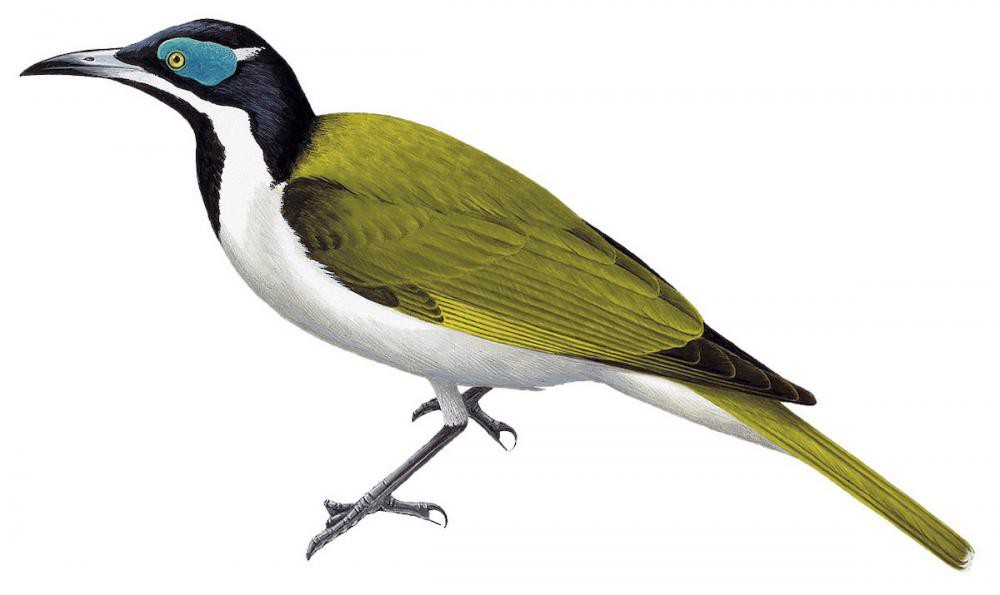Blue-faced Honeyeater / Entomyzon cyanotis

Blue-faced Honeyeater
SCI Name:
Protonym: Gracula cyanotis Suppl.ind.orn. p.xxix
Taxonomy: Passeriformes / Meliphagidae / Entomyzon
Taxonomy Code: blfhon1
Type Locality: Nova Hollandia [= Sydney, New South Wales, cf. Stresemann, 1951, Emu, 50, p. 68].
Author: Latham
Publish Year: 1801
IUCN Status:
DEFINITIONS
ENTOMYZON
(Meliphagidae; Ϯ Blue-faced Honeyeater E. cyanotis) Gr. εντομα entoma insects < εντομη entomē notch; Mod. L. myza honeyeater < μυζαω muzaō to suck; "BLUE-CHEEKED HONEYSUCKER ... This bird is fond of pecking traverse holes in the bark, between which and the wood it inserts its long tongue in search of small insects, drawing them out with great dexterity" (Lewin 1808) (pace Higgins et al. 2001: "Entomyzon is from Greek εντομη, a notch, an incision, and Modern Latin myzon, a honeyeater, with reference to the large oval nostrils placed in the middle of the bill”); “The Australasian Meliphagidæ, with the exception of one type,* derive their principal sustenance, as it is well known, from the nectar of flowers ... * Entomyzon, (Mihi). The blue-faced Grakle of Latham, whose filamentous tongue is used for extracting small insects from between the broken bark on the stems of trees; which are climbed by this bird somewhat in the same manner as a Woodpecker. See Lewin's Birds of New Holland. A more beautiful connection between the Scansores and the Tenuirostres could hardly be imagined.” (Swainson 1825); "Entomyzon Swainson, 1825, Zool. Journ., 1, p. 480. Type, by original designation [= by monotypy], "Blue-faced Grackle of Latham" = Gracula cyanotis Latham." (Salomonsen in Peters, 1967, XII, p. 399).
Var. Entomisa, Entomiza, Entomizon, Entomyza.
cyanotis / cyanotos
Gr. κυανος kuanos dark-blue; -ωτις -ōtis -eared < ους ous, ωτος ōtos ear.
● ex “Grand Grimpar” of Levaillant 1807 (?syn. Xiphocolaptes albicollis).
Cyanotis
(Tyrannidae; syn. Tachuris † Many-coloured Rush Tyrant T. rubrigastra) Gr. κυανος kuanos dark-blue; -ωτις -ōtis -eared < ους ous, ωτος ōtos ear; "Cyanotis, Sw. Habit of Regulus. Wings slightly rounded; the first and second quill very little shorter than tht third. Tail rounded, obtuse. Feet uncommonly large and slender. Inner toe much shorter than the outer. Claws very long, and but slightly curved. Brazil. R. omnicolor. Vieil. ... This seems the tropical representation of Regulus: it is at once known by its disproportionately long toes and claws. It is the Reg. Byronensis of Griff. Cuv." (Swainson 1837); "Cyanotis Swainson, 1837, Nat. Hist. Classification Birds, II, p. 243. Type, by monotypy, Regulus omnicolor Vieillot, 1824 = Sylvia rubrigastra Vieillot, 1817." (JAJ 2021).
SUBSPECIES
Blue-faced Honeyeater (White-quilled)
SCI Name: Entomyzon cyanotis albipennis
albipennis
L. albus white; pennis wings, -winged < penna feather.
Blue-faced Honeyeater (Blue-faced)
SCI Name: Entomyzon cyanotis [cyanotis Group]
ENTOMYZON
(Meliphagidae; Ϯ Blue-faced Honeyeater E. cyanotis) Gr. εντομα entoma insects < εντομη entomē notch; Mod. L. myza honeyeater < μυζαω muzaō to suck; "BLUE-CHEEKED HONEYSUCKER ... This bird is fond of pecking traverse holes in the bark, between which and the wood it inserts its long tongue in search of small insects, drawing them out with great dexterity" (Lewin 1808) (pace Higgins et al. 2001: "Entomyzon is from Greek εντομη, a notch, an incision, and Modern Latin myzon, a honeyeater, with reference to the large oval nostrils placed in the middle of the bill”); “The Australasian Meliphagidæ, with the exception of one type,* derive their principal sustenance, as it is well known, from the nectar of flowers ... * Entomyzon, (Mihi). The blue-faced Grakle of Latham, whose filamentous tongue is used for extracting small insects from between the broken bark on the stems of trees; which are climbed by this bird somewhat in the same manner as a Woodpecker. See Lewin's Birds of New Holland. A more beautiful connection between the Scansores and the Tenuirostres could hardly be imagined.” (Swainson 1825); "Entomyzon Swainson, 1825, Zool. Journ., 1, p. 480. Type, by original designation [= by monotypy], "Blue-faced Grackle of Latham" = Gracula cyanotis Latham." (Salomonsen in Peters, 1967, XII, p. 399).
Var. Entomisa, Entomiza, Entomizon, Entomyza.
UPPERCASE: current genus
Uppercase first letter: generic synonym
● and ● See: generic homonyms
lowercase: species and subspecies
●: early names, variants, mispellings
‡: extinct
†: type species
Gr.: ancient Greek
L.: Latin
<: derived from
syn: synonym of
/: separates historical and modern geographic names
ex: based on
TL: type locality
OD: original diagnosis (genus) or original description (species)












